
A lynx is any of the four extant species within the medium-sized wild cat genus Lynx. The name originated in Middle English via Latin from the Greek word lynx (λύγξ), derived from the Indo-European root leuk-, in reference to the luminescence of its reflective eyes.

Haemodoraceae is a family of perennial herbaceous flowering plants with 14 genera and 102 known species. It is sometimes known as the "bloodroot family". Primarily a Southern Hemisphere family, they are found in South Africa, Australia and New Guinea, and in the Americas. Perhaps the best known are the widely cultivated and unusual kangaroo paws from Australia, of the two closely related genera Anigozanthos and Macropidia.

Desmans are diving insectivores of the tribe Desmanini in the mole family, Talpidae.

The Townsend's mole is a fossorial mammal in the family Talpidae, and is the largest North American mole. It was named after the American naturalist John Kirk Townsend. The name was selected at the request of Thomas Nuttall as a patronym to honor Townsend's contribution.

The bushy-tailed opossum is an opossum from South America. It was first described by English zoologist Oldfield Thomas in 1912. It is a medium-sized opossum characterized by a large, oval, dark ears, fawn to cinnamon coat with a buff to gray underside, grayish limbs, and a furry tail. Little is known of the behavior of the bushy-tailed opossum; less than 25 specimens are known. It appears to be arboreal (tree-living), nocturnal and solitary. The diet probably comprises insects, eggs and plant material. This opossum has been captured from heavy, humid, tropical forests; it has been reported from Bolivia, Brazil, Colombia, Ecuador and Peru. The IUCN classifies it as least concern.

Asimina triloba, the American papaw, pawpaw, paw paw, or paw-paw, among many regional names, is a small deciduous tree native to the eastern United States and southern Ontario, Canada, producing a large, yellowish-green to brown fruit. Asimina is the only temperate genus in the tropical and subtropical flowering plant family Annonaceae, and Asimina triloba has the most northern range of all. Well-known tropical fruits of different genera in family Annonaceae include the custard-apple, cherimoya, sweetsop, ylang-ylang, and soursop.

Leucauge is a spider genus of long-jawed orb weavers, with over 160 species and fully pantropical distribution.
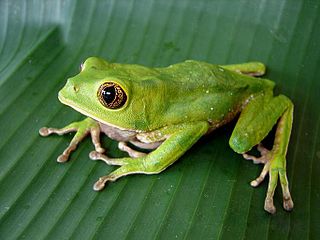
Phyllomedusa venusta is a species of frog in the subfamily Phyllomedusinae, found in Colombia and Panama. Scientists have seen it between 800 and 1400 meters above sea level.

Derbidae is a family of insects in the order Hemiptera, the true bugs. It is one of the largest and most diverse families of planthoppers. It is widely distributed around the world, especially in the tropics, and with many species in subtropical and temperate regions.

Acanalonia is a genus of planthopper and contains the majority of the species within the family Acanaloniidae. Species have been recorded from southern Europe and the Americas.

Pyrostegia venusta, also commonly known as flamevine or orange trumpet vine, is a plant species of the genus Pyrostegia of the family Bignoniaceae originally native to southern Brazil, Bolivia, northeastern Argentina and Paraguay; today, it is also a widely cultivated garden species.

Tropiduchidae is a family of planthoppers in the order Hemiptera. There are at least 160 genera and 600 described species in Tropiduchidae.
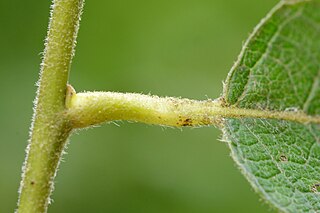
Euura venusta is a species of sawfly belonging to the family Tenthredinidae. The larvae feed within the leaf-stalk of willows forming a gall. The sawfly was first described by Carl Gustav Alexander Brischke in 1883.

Nothodelphax is a genus of delphacid planthoppers in the family Delphacidae. There are more than 20 described species in Nothodelphax.

Achilidae is a family of planthoppers, sometimes called "achilids" in the order Hemiptera. There are at least 520 described species in Achilidae.
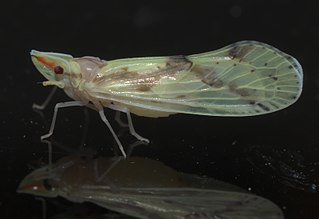
Otiocerus is a genus of derbid planthoppers in the family Derbidae. There are about 16 described species in Otiocerus.

Aplos is a genus of issid planthopper with only one species, Aplos simplex. It can be found in most of the Eastern United States and is now found as an invasive species in Northern Italy and Austria. Aplos simplex was formerly listed under the genus Thionia.
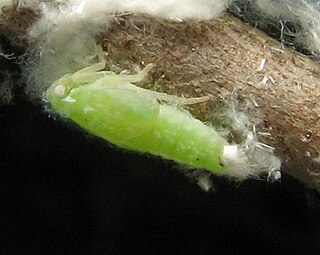
Ormenoides is a genus of North American flatid planthoppers in the family Flatidae. Usually adults are 7 to 7.5 mm in length and 2 mm in width.

The Achilixiidae are a family of Fulgoromorpha (planthoppers); species may be found in the neotropical and Asian regions. They are closely related to Achilidae and are sometimes included under Achilidae as a subfamily. Like Achilidae, species generally feed on several species of plant though the nymph stage has been found to feed on fungus. Like other planthoppers, the immature stage is covered in a wax which may help protect it from predators. Achilixiidae are small or medium sized for planthoppers and are greatly compressed, not depressed like the Achilidae.
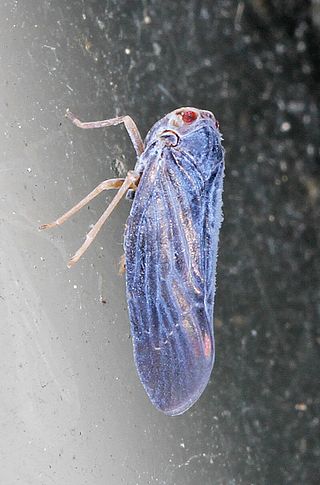
Cedusa is a genus of derbid planthoppers in the family Derbidae. There are more than 170 described species in Cedusa.





















